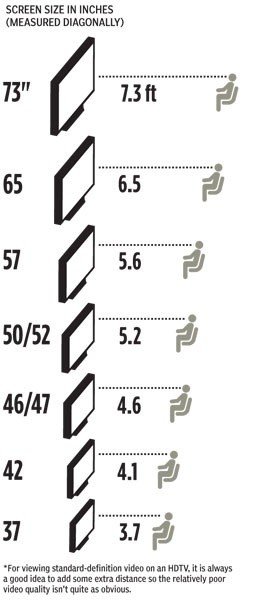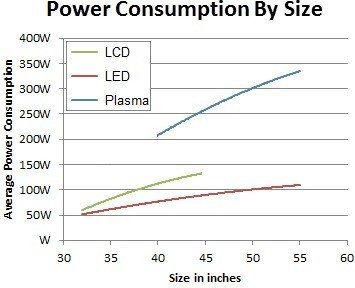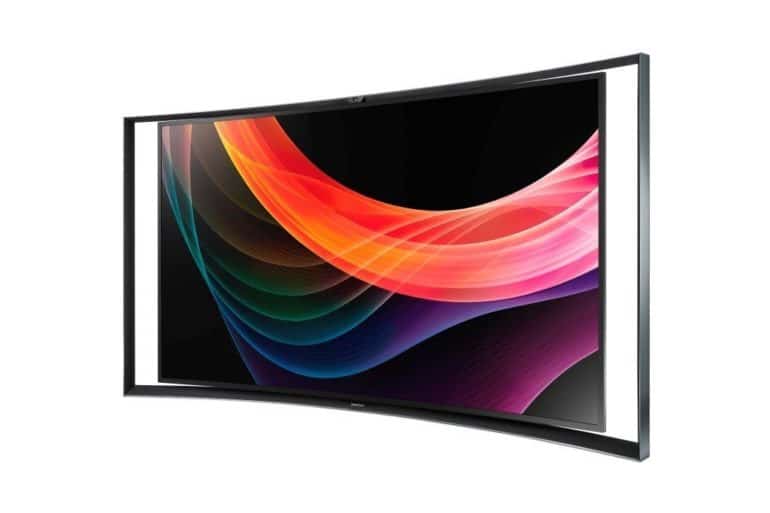Table of Contents
Screen Size
Screen size is the first and foremost thing you should consider while buying a new TV. Most new TV buyers compromise on the screen size and instead go for the fancy-sounding features that they hardly use. To determine the perfect screen size, check out the approx. distance between the viewers and TV. The rough calculation for arriving at the minimum and maximum size is by dividing the viewing distance by 3 and 1.5 respectively.
For example, if the viewing distance is 6 feet (72 inches) then the minimum screen size preferred for you would be 24″ and maximum of 48″ (72″ divided by 3 & 1.5 respectively). Here’s a quick infographic suggestion on the recommended screen size depending on the distance between viewers and TV.

(Image credit: PC Mag)
Picture Quality, Resolution and Screen Technology
As you may have understood by now, arriving at an ideal screen size is not a big deal as long as you are aware of the distance you’ll be watching the TV from. The other confusion comes in choosing LCD V/s LED and the screen resolution i.e. full HD v/s partial HD. We’ll help you understand why you should choose one over the other.
Resolution – Ultra HD V/s Full HD v/s Partial HD:
Well, when you are spending a hefty amount of money, you sure would want to go for a full HD TV but here’s a secret that many TV sellers won’t tell you. It is very rare that you get full-HD (1920 x 1080) content in India, as most of the HD channels, including the ones available with Airtel Digital and Dish TV, have partial HD resolution i.e. 1280 x 780 pixels.
So, it makes absolutely no sense in paying a premium of around 30-50% for a full HD TV if the content you’ll be viewing will be in a partial HD format. But if you are a person who likes to stream full HD videos and watch movies from your wireless devices & Blu-Ray players or any other flash drives, then it surely makes sense to invest in a full HD 1080P display.
Apart from full HD and partial HD, there’s a new term heard about in the television market known as 4K TV. Ultra HD TV or 4K TV as they are popularly known are TVs having screen resolution of 3840×2160 pixels, double of what full HD has. But just like HD TV, 4K TV has the disadvantage of limited content in UHD format, let TV content be alone, there’s very bleak chances that you’ll be getting your favorite movies in this resolution. Again, just like HD TV, the partial HD content are scaled up for viewing in UHD format which would obviously not feel as good as they would, had they been in 4K resolution originally. So it surely makes no sense buying UHD/4K TV unless you’re planning to use it for a decade or so.
Screen Technology: OLED V/s LCD V/s LED:
Initially, you may not find lots of difference between LCD and LED TVs, besides their pricing. LED based LCD TVs are priced substantially more than their LCD counterpart. Once again, there is a catch and a lot of difference in the technology behind both these TVs. The major difference between the two being the tech they use for illuminating the screen. While LCD TVs use CCFL based light bars on the edge of the screen, LED based LCD TVs (generally referred as LED TV) use light emitting diodes behind the LCD panels.
Many of you may be questioning the advantages of having an LED TV over LCD TV and paying a premium for the same. That’s a valid question. Here are a couple of reasons why it is worth paying the premium for LED and why people choose the latter over the former:
1. Since multiple LEDs could be placed behind the LCD screen, the lighting on LED based LCD TVs is even which in turn makes the TV viewing experience better
2. Since CCFL based light bars are placed on the edge of the screen, it has to be bright enough to lighten the center most part of the screen, this in turn makes the distribution of lighting on LCD screens very uneven and also consumes high amount of power thus increasing your electricity bills.
3. Other advantages of LED based LCD TV includes greater reliability, light weight, lower temperature, less environment pollution on disposal, etc.
Apart from LCD and LED, there’s also a third technology in place in display manufacturing called as OLED. Unlike LED and LCD TVs where LED lights / CCFL light bars are placed behind the screen of the TV, OLED screen based TV doesn’t need LED lights to be placed behind the screen, but each pixel of the OLED screen is itself illumiated, thanks to the fast pace growth of technology. Since there’s no need for placing light bars/LED bulbs the thickness of OLED TVs are substantially lower than their LCD and LED counterparts. But unfortunately OLED screen TVs would cost you bomb which is the reason behind OLED TV not getting popular in the market.
Energy Efficiency:
As mentioned earlier, LED TVs save a huge amount of energy when compared to their LCD counterparts, but there is still scope left for cutting down on the energy consumption. Most of the electronic devices sold in the market today have energy rating which helps you determine how friendly the device is, as compared to other products in the market. The more energy saving star a device has, the more energy saving and environment friendly it would be. Though this is an elementary thing, many buyers miss checking the energy efficiency level. You may find out more about energy rating label on their official website.

(Image credit: Rtings.com)
Connectivity Features:
With modern TVs, watching television programs is not the only thing you can do. There are many other productivity enhancement features amid the fancy customer wooing features that you may want to check out for, before finalizing a model. Listed below are few such useful features:
Wi-Fi Direct:
This is a cool feature you must look out for on your new TV. Using Wi-Fi Direct, you can view multimedia contents from your mobile device and enjoy viewing images or videos from your mobile or portable device with your entire family. Other technologies include the likes of DLNA, which has been invented by Sony.
Miracast is also another technology that enables screen mirroring from a mobile device. Newer devices that have Miracast connectivity include the likes of the Samsung Galaxy Note III, Sony Xperia Z1, LG G2 and the Xperia C.
|
Technology |
Needs Wi-Fi Router |
Functionality |
Introduced by |
|
Wi-Fi Direct |
No |
Multimedia streaming |
Wi-Fi Alliance |
|
Miracast |
No |
Screen mirroring |
Wi-Fi Alliance |
|
DLNA |
Yes |
Multimedia sharing from DLNA servers |
Sony |
|
WiDi |
No |
Screen mirroring from notebooks |
Intel |
Social networking:
Found in many television sets these days, including the ones from Samsung (named as Smart Hub), this feature keeps your updated with your Facebook friends status and people you’re following on Twitter including updates from other social media sites like LinkedIn, YouTube, etc. In fact, Samsung offers many such TVs that are quite affordable and include smart features. For a detailed list, visit the Samsung TV price list.
Web Browsing:
Gone are the days when web browsing was only possible on computer systems and mobile devices. Thanks to these modern day TVs, you can now browse websites even on a television.

